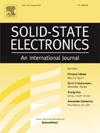Maximum, effective, and average thermal resistance for GaN-based HEMTs on SiC, Si and sapphire substrates
IF 1.4
4区 物理与天体物理
Q3 ENGINEERING, ELECTRICAL & ELECTRONIC
引用次数: 0
Abstract
The maximum, effective, and average thermal resistance (RTH) of AlGaN/GaN and InAlN/GaN high-electron mobility transistors (HEMTs) on silicon carbide (SiC), silicon (Si), and sapphire substrates are reported using TCAD simulation. After validating simulated I-V properties, RTH is deduced from self-heating (SH)-induced rise in channel temperature (ΔT) versus dissipated power (PD) plot. The maximum thermal resistance (RTHmax) determines HEMT reliability at higher power dissipation; so, peak channel temperature (Tmax) is extracted. The simulated ΔTmax-PD plots are compared with the literature results for each HEMT structure. The estimated RTHmax is consistent with the reported experimental values, verifying the TCAD model and confirming the validity of reported RTH values. The effective thermal resistance (RTHeff) is needed to simulate the electrical properties using the compact model. For this purpose, isothermal IDS-VDS simulations are carried out at different temperatures without SH effects. Then, the cross-over temperature points (ΔTeff) are identified by evaluating the isothermal data with the actual output properties at a particular PD. The average thermal resistance (RTHavg) of the HEMT is computed by averaging the lattice temperature profile along the channel (mean channel temperature), and RTHavg is compared with RTHeff.
氮化镓基hemt在SiC, Si和蓝宝石衬底上的最大,有效和平均热阻
通过 TCAD 仿真,报告了碳化硅 (SiC)、硅 (Si) 和蓝宝石衬底上的 AlGaN/GaN 和 InAlN/GaN 高电子迁移率晶体管 (HEMT) 的最大、有效和平均热阻 (RTH)。在验证了模拟的 I-V 特性后,从自热 (SH) 引起的沟道温度上升 (ΔT)与耗散功率 (PD) 的关系图中推导出 RTH。最大热阻 (RTHmax) 决定了 HEMT 在更高功率耗散时的可靠性;因此,要提取峰值沟道温度 (Tmax)。模拟的 ΔTmax-PD 图与每种 HEMT 结构的文献结果进行了比较。估计的 RTHmax 与报告的实验值一致,验证了 TCAD 模型,并确认了报告的 RTH 值的有效性。使用紧凑模型模拟电特性需要有效热阻 (RTHeff)。为此,在无 SH 影响的不同温度下进行了等温 IDS-VDS 模拟。然后,通过评估特定 PD 下的等温数据和实际输出特性,确定交叉温度点 (ΔTeff)。HEMT 的平均热阻 (RTHavg) 是通过平均沿沟道的晶格温度曲线(平均沟道温度)计算得出的,并将 RTHavg 与 RTHeff 进行比较。
本文章由计算机程序翻译,如有差异,请以英文原文为准。
求助全文
约1分钟内获得全文
求助全文
来源期刊

Solid-state Electronics
物理-工程:电子与电气
CiteScore
3.00
自引率
5.90%
发文量
212
审稿时长
3 months
期刊介绍:
It is the aim of this journal to bring together in one publication outstanding papers reporting new and original work in the following areas: (1) applications of solid-state physics and technology to electronics and optoelectronics, including theory and device design; (2) optical, electrical, morphological characterization techniques and parameter extraction of devices; (3) fabrication of semiconductor devices, and also device-related materials growth, measurement and evaluation; (4) the physics and modeling of submicron and nanoscale microelectronic and optoelectronic devices, including processing, measurement, and performance evaluation; (5) applications of numerical methods to the modeling and simulation of solid-state devices and processes; and (6) nanoscale electronic and optoelectronic devices, photovoltaics, sensors, and MEMS based on semiconductor and alternative electronic materials; (7) synthesis and electrooptical properties of materials for novel devices.
 求助内容:
求助内容: 应助结果提醒方式:
应助结果提醒方式:


